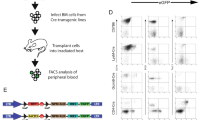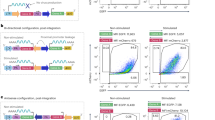Abstract
The haematopoietic system is made up of a hierarchy of cells with different developmental, functional and proliferative capacities. Although cellular diversity appears to arise from the commitment and maturation of stem cells, the molecular basis for this differentiation process is unknown. The introduction of cloned DNA sequences into haematopoietic progenitor cells would provide a novel approach for studying this differentiating in vivo system. One laboratory has reported DNA-mediated transfer of genes into mouse bone marrow cells1,2. However, retroviruses offer a number of advantages over DNA-mediated gene transfer procedures, including high efficiency infection of a wide range of cell types in vitro and in vivo, stable and low copy integration into the host chromosome, and a defined integrated provirus structure. For these reasons recombinant DNA techniques have been utilized to construct high efficiency retrovirus vectors expressing foreign genes3–8. We demonstrate here, using such a retrovirus vector, the transfer of a dominant selectable drug-resistance gene into defined classes of mouse haematopoietic progenitor cells. These observations should facilitate the development of molecular genetic approaches to fundamental and clinical problems in haematopoiesis.
This is a preview of subscription content, access via your institution
Access options
Subscribe to this journal
Receive 51 print issues and online access
$199.00 per year
only $3.90 per issue
Buy this article
- Purchase on Springer Link
- Instant access to full article PDF
Prices may be subject to local taxes which are calculated during checkout
Similar content being viewed by others
References
Cline, M. J. et al. Nature 284, 422–425 (1980).
Mercola, K. E., Stang, H. D., Browne, J., Salser, W. & Cline, M. J. Science 208, 1033–1035 (1980).
Shimotohno, K. & Temin, H. Cell 26, 67–78 (1981).
Wei, C.-M., Gibson, M., Spear, P. G. & Scolnick, E. M. J. Virol. 39, 935–944 (1981).
Tabin, C. J., Hoffman, J. W., Goff, S. P. & Weinberg, R. A. Molec. cell. Biol. 2, 426–436 (1982).
Sorge, J. & Hughes, J. H. J. Molec. appl. Genet. 1, 547–559 (1982).
Joyner, A. L. & Bernstein, A. in Gene Transfer and Cancer (eds Pearson, M. & Sternberg, W.) (Raven, New York, in the press).
Joyner, A. & Bernstein, A. Molec. cell. Biol. (in the press).
Colbere-Garapin, F., Horodniceanu, F., Kourilsky, P. & Garapin, A.-C. J. molec. Biol. 150, 1–14 (1981).
Southern, P. J. & Berg, P. Molec. appl. Genet. 1, 327–341 (1982).
Johnson, G. R. & Metcalf, D. Proc. natn. Acad. Sci. U.S.A. 74, 3879–3882 (1977).
Manzari, V. et al. Proc. natn. Acad. Sci. U.S.A. 80, 11–15 (1983).
Mann, R., Mulligan, R. C. & Baltimore, D. Cell 33, 153–159 (1983).
Wahl, G., Stern, M. & Stark, G. Proc. natn. Acad. Sci. U.S.A. 76, 3683–3687 (1979).
Author information
Authors and Affiliations
Rights and permissions
About this article
Cite this article
Joyner, A., Keller, G., Phillips, R. et al. Retrovirus transfer of a bacterial gene into mouse haematopoietic progenitor cells. Nature 305, 556–558 (1983). https://doi.org/10.1038/305556a0
Received:
Accepted:
Issue Date:
DOI: https://doi.org/10.1038/305556a0
This article is cited by
-
Identification of immature podocyte specific antigen using retrovirus-mediated gene transfer and cell sorting
Clinical and Experimental Nephrology (2005)
-
The origin of hematopoietic cell type diversity
Oncogene (2004)
-
Retrovirus-mediated gene transfer into CD4+ and CD8+ human T cell subsets derived from tumor-infiltrating lymphocytes and peripheral blood mononuclear cells
Cancer Immunology Immunotherapy (1991)
Comments
By submitting a comment you agree to abide by our Terms and Community Guidelines. If you find something abusive or that does not comply with our terms or guidelines please flag it as inappropriate.



